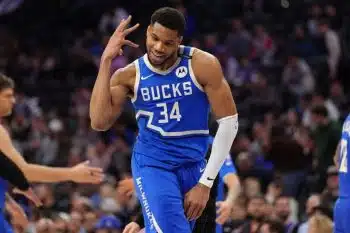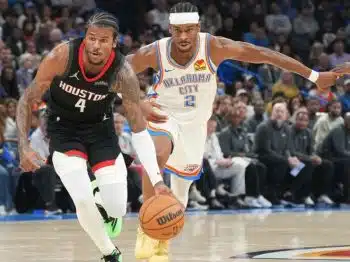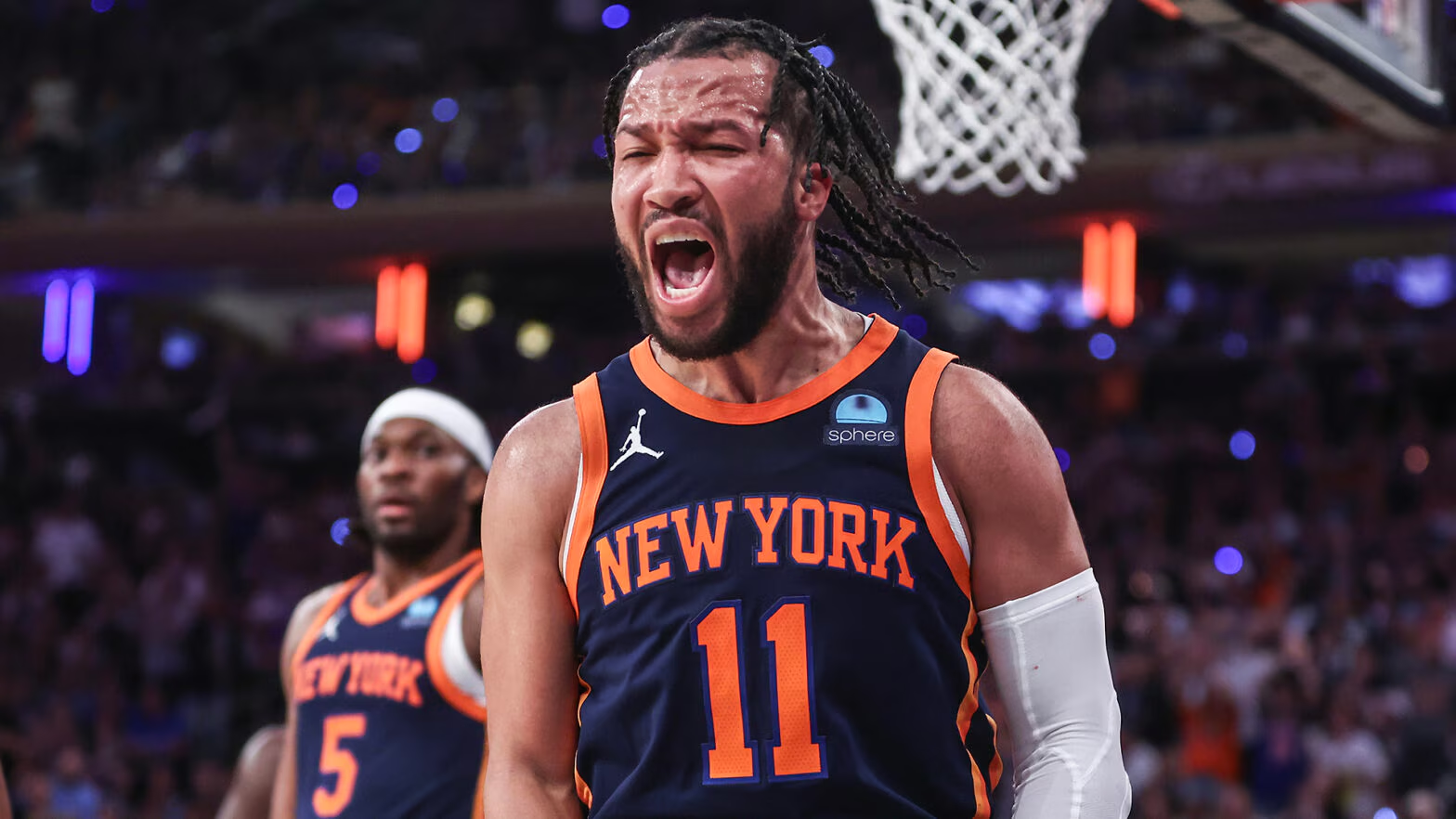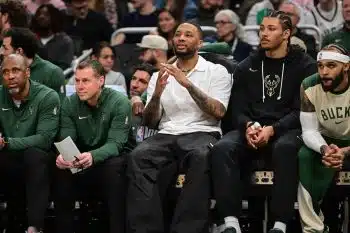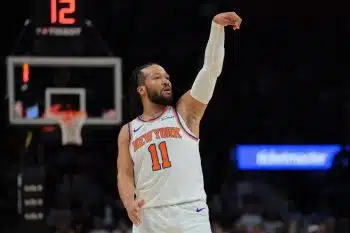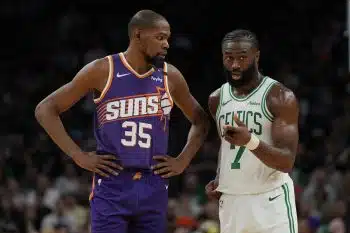NBA
Boston Celtics 2019-20 NBA Season Preview
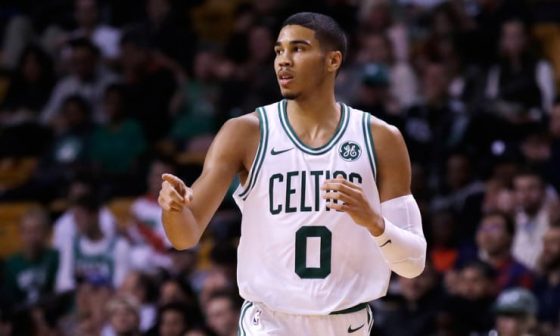
The Boston Celtics weren’t the team we thought they would be a season ago.
Alongside the Golden State Warriors, the Celtics were expected to pace the NBA. In fact, most pegged them the class of the Eastern Conference, with a chance to topple those same Warriors from the NBA mountain top.
That, clearly, wasn’t the case. With the amount of talent that some teams could only dream of, Boston just couldn’t put it together.
Jayson Tatum didn’t take the step many had hoped for (some might say he regressed, even), while Gordon Hayward looked like a husk and Jaylen Brown struggled as a reserve. There was a clear disconnect between the roster’s veterans and youth, and management did relatively little to remedy the situation.
Now, among others, Kyrie Irving and Al Horford are gone and, because of that, the Celtics are a different team. The way they approach the season, and the way they handle their personnel, should see major change.
But, it would seem as if the same question is being asked of the team, if not with a different tone: how far can they go?
The sky was the limit a season ago, but now? It’s hard to say.
FIVE GUYS THINK…
The 2019 offseason was not a kind one to the guys in green. Having lost Kyrie Irving, Marcus Morris and surprisingly Al Horford, core pieces were lost to say the least. However, with this comes opportunity, and Jaylen Brown and Jayson Tatum are looking forward to taking the ball and running with it. The Celtics went out and brought in Kemba Walker to fill the All-Star point guard void, and Enes Kanter will likely assume starting duties in the middle. Considering how much those two love the pick-and-roll and pick-and-pop game, it could be a match made in heaven. Perhaps what’s forgotten in all this is Gordon Hayward is going to be a focal point for the first time in years, and the 29-year-old showed signs of his old self in spurts last season. The bench could be inexperienced with a couple of rookies mixed in there, but the leadership of Marcus Smart with that unit may be enough to guide them along. Brad Stevens loves a challenge. And unlike the managing of egos and disagreements behind closed door, *this* seems to be the kind of challenge he thrives on.
2nd Place – Atlantic Division
– Spencer Davies
The Celtics may have lost Kyrie Irving, but they did replace him with Kemba Walker so don’t expect too much of a drop off on that front. Who they’re really going to miss though is Al Horford. Horford was their best interior defender and a capable scorer. They don’t have anyone on the roster who can replicate his production. What they’re really counting on, to avoid taking a step backwards, is the development of Jayson Tatum and Jaylen Brown. With a healthy Gordon Hayward, as well as Irving, there was only so many touches to go around. When the two were injured during the 2018 playoffs, both Tatum and Brown thrived with the offensive touches they got. They both took steps back last season overall, however. For the Celtics to try and offset the loss of Horford, they’ll need those two to regain their 2018 forms. They didn’t make much a splash on the free agent front, and they’re going to be expecting big roles from relatively unproven players like Robert Williams III and Semi Ojeleye. They’re still good enough to be a playoff team, but unless Tatum and Brown project upward, then they might find themselves without home court in the first round.
3rd Place – Atlantic Division
– David Yapkowitz
The Celtics had a tough offseason. They swapped out Kyrie Irving and Al Horford for Kemba Walker and Enes Kanter – which is a net negative from a talent standpoint. But there is still ample talent on Boston’s roster. And there is still redundancy at the wing position, with Gordon Hayward, Jaylen Brown, Jayson Tatum and Marcus Smart all posturing for many of the same minutes. But Celtics depth continues to be a good problem to figure out for Coach Brad Stevens. And with Walker now leading the Celtics, there is likely to be fewer disgruntled players in the Boston locker room. Rookies Romeo Langford, Carsen Edwards, Tremont Waters and Grant Williams all show promise – but there obviously won’t be the requisite minutes for all of them to develop on the NBA team. Some – if not all – will spend a portion of the upcoming season with their G-League affiliate. The Celtics might have taken a step back from a talent standpoint, but they’ve added some much-needed stability. And with the league’s elite talent spreading across more teams (e.g., Kevin Durant leaving Golden State for Brooklyn), there is less of a need for a “big four.” So the Celtics picked a good year for this experiment, even if the plan was forced on them and not entirely theirs to pick.
3rd Place – Atlantic Division
– Drew Maresca
Let’s be honest, you never want to lose talent in the NBA for nothing in return, let alone an All-Star talent like Kyrie Irving. However, if you do, Kemba Walker is not a bad consolation prize. In fact with the Celtics team chemistry being such a mess last season, Walker’s personality and style of leadership might actually make the Celtics a better fitting team this season which is a plus. The Celtics are going to miss Al Horford, not only was he a monster on the floor he was the big brother in the locker room that helped a lot of guys through the ups and downs of the season. That is a big void to fill. All in, the Celtics still look like a contender. They have fewer mouths to feed and that should help guys get in a rhythm a little easier. All said, the Celtics look like a more balanced team today and if any of the young guys take that next big step forward in their development, the Celtics should be in contention for home court.
2nd Place – Atlantic Division
– Steve Kyler
This was an interesting offseason for the Boston Celtics. Losing Al Horford is more significant than Kyrie Irving opting to join the Brooklyn Nets, in my opinion. Horford has been a huge difference-maker in the the lats few postseasons and is a good character guy to have around. Irving, on the other hand, never seemed to gel with the Celtics and was a disruptive presence during his time in Boston. Kemba Walker may not have as much raw talent as Irving, but he isn’t far off and should be a much better fit both on the court and in the locker room. Also, credit Boston for adding guys like Enes Kanter, Romeo Langford, Grant Williams and Carsen Edwards. Kanter is talented offensively and not as inept defensively as many may have you believe. To be clear, Boston lost a lot of talent this offseason, but made solid moves to fill out the roster. The hope is with more opportunity, young players like Jayson Tatum and Jaylen Brown can take a step forward in their development and fill the void.
2nd Place – Atlantic Division
– Jesse Blancarte
FROM THE CAP GUY
The Celtics quickly pivoted when it became clear that Kyrie Irving didn’t intend to stay. By executing a dual sign and trade with the Charlotte Hornets that brought in Kemba Walker for Terry Rozier, Boston triggered a hard cap at $138.9 million. That shouldn’t be an issue given the team has used all of its cap space and room exception (on Enes Kanter) to reach $117.9 million in guaranteed salary.
Before November, the Celtics will need to pick up team options on Jayson Tatum and Robert Williams. Jaylen Brown is eligible for a contract extension until the start of the season. While Boston might have enough cap room next summer to sign a maximum-salaried player, players options (Gordon Hayward at $32.7 million and Enes Kanter at $5 million) and Brown’s cap hold as a restricted free agent ($19.6 million) suggests the team is unlikely to be a big spender in July.
– Eric Pincus
TOP OF THE LIST
Top Offensive Player: Kemba Walker
In his two seasons in Boston (and with Brad Stevens), Irving posted some of the best numbers of his career. Now, in a similar role, Kemba Walker is set to do the same.
Already a potent offensive weapon, Walker averaged 25.6 points, 4.4 rebounds, 5.9 assists and shot 43.4% from the field with the Charlotte Hornets last season. Irving, in arguably his career-best stretch, posted similar numbers (24.1, 4.4, 6.1, 48.9%), so it wouldn’t be ridiculous to think Stevens could push Walker to another level.
Even with the Celtics’ many departures, Walker is about the step into a primary role on a team more talented than any he was a part of in Charlotte. With those inferior rosters, Walker managed three All-Star appearances and an All-NBA appearance.
So, as Boston’s lead man? Expect Walker to take a leap.
Top Defensive Player: Marcus Smart
With Horford gone, there wasn’t much debate here. Boston has multiple versatile defensive weapons, but Marcus Smart is the best among them.
Defense has been the Celtics’ identity for years, and Marcus Smart has been at the heart of it, perhaps more so than ever last season. Smart finished eighth in the vote for Defensive Player of the Year and was a first-time member of the All-Defensive first team. Smart also finished third in the NBA in total steals (143) and sixth in steals per game (1.8).
He isn’t the biggest, nor the strongest, but Smart has shown the ability to excel, regardless of the defensive matchup. His defensive instincts are impeccable, as is his tenacity – ala Patrick Beverley, Smart is never one to give up on a play.
Smart also has a knack for making plays when the team is desperate for one. Whether a deflection, forced an errant pass or an outright block or steal, Smart can often be found in the thick of it late in games.
Top Playmaker: Kemaba Walker?
There isn’t an elite passer in this group, but there are a number of different players that could take on the mantle come season’s end.
Walker would be the obvious candidate, as his 5.9 assists per game last season would lead the Celtics’ current group. Smart, who thrived as a secondary playmaker last season, would also seem like an easy choice here.
Hayward’s career average of 3.4 assists per game doesn’t look like much, but the forward has solid passing skills and the team could look to employ him as a point-forward in certain situations.
The most likely scenario? Boston can (and probably should) look to Frankenstein their abilities together. They aren’t Chris Paul or Russell Westbrook, but together the three of them should be able to make a serious impact.
Top Clutch Player: Kemba Walker
Walker has long been regarded as clutch. And, as he has in almost every other facet, he should step in nicely for Irving as Boston’s go-to guy.
By virtue of his situation in Charlotte, Walker’s field goal percentage in the clutch, the last five minutes of the fourth quarter or overtime and the score within five, doesn’t impress (49.6%) — he had to take almost every shot, because there just wasn’t anyone else that could. Still, Walker finished the regular season with the third-most field goals in those situations (52), just five behind Irving (57) and ahead of Stephen Curry (31), Kevin Durant (31), James Harden (47), Damian Lillard (36) and others.
Plenty of his teammates — Brown, Hayward, Tatum, etc. — can and will get up shots late in games. But, when the Celtics need a bucket, they’ll have a guy in Walker that can get it done when- and wherever.
The Unheralded Player: Jaylen Brown
Brown regressed in 2019, but not nearly as much as some would make it out to be.
He struggled early on due to a hand injury and, by the time he got back Boston was in the midst of a meltdown. Stevens moved him to the bench and it took some time for him to adjust but, once he did, he took off.
In Brown’s last 37 games, he averaged 14 points, 4.4 rebounds, 1.1 steals and shot 38.2% from three. Only Paul George, T.J. Warren, Curry and Irving posted those numbers while playing more than 40 games last season.
With a chunk of the offense production gone from last year, expect Brown to not only take on a greater role with the team, but another step forward, career-wise, in the last year of his deal.
Best New Addition: Grant Williams
Of course, Walker would fit the bill as the best new addition. But, to highlight someone else, let’s take a look at rookie Grant Williams.
There is a lot to like about the big-man out of Tennessee. At 6-foot-7, Williams has the size to play at either the power forward or center spot and should hold his own against most players, small or large, defensively. He can score efficiently, pass effectively and can even step out and make an impact on the perimeter.
Williams would seem to fit the mold of the do-it-all front court chess piece. Depending on where he is at, development-wise, he could seize a large role relatively early in his rookie season as the Celtics look to fill the Horford-sized hole left in the roster.
If not, Williams should develop into a solid player, and one the team can build with, as the Celtics look to turn their team around after last season.
– Shane Rhodes
WHO WE LIKE
1. Grant Williams
To reiterate, there is a lot to like about Williams and what he could do at the NBA level.
He was exceptional in nearly every phase of the game at Tennessee — he can shoot, pass and defend at a high level — and he has the motor that any team would want to see in a rookie. In his third year with the team, Williams averaged 18.8 points, 7.5 rebounds, 3.2 assists and shot 56.4% from the floor (32.6% from three).
Williams has also shown to be a team-first player, an attitude the Celtics sorely lacked last season, and should go a long way in bringing the locker room together.
He also impressed in Summer League and, given Boston’s options at power forward and center, Williams could step into a relatively large role out of the gate. If that’s the case and, should he hold his own, Williams could prove one of the biggest steals of the 2019 NBA Draft.
2. Carsen Edwards
Carsen Edwards can flat out score. And that’s exactly why the Celtics brought him in.
Boston struggled to score points off the bench last season, so they added the diminutive guard in the second round of the draft. Edwards scored easily and often during his time at Purdue, and even stepped up his game in the NCAA tournament and shined with the Celtics in the Summer League. He can score at every level — near the basket, mid-range and from three — and isn’t afraid of any matchup.
That confidence should bode well, both for Boston and Edwards. Even as a second-round rookie, expect some big nights out of him in his first season.
3. Gordon Hayward
Two seasons removed from his gruesome leg injury, this may be the year Hayward looks like himself again.
Many thought Hayward would take that step last season, but he struggled with his confidence and often looked lost on the court. Stevens tried to force-feed him the ball, but he only struggled further and the team worse for it (both on the court and in the locker room).
But now, with two years and an injury-free offseason between him and the original injury, Hayward may be able to take that massive step back toward the player he once was.
If Hayward can make that triumphant return to the court, it could completely change other teams view Boston and their place in the NBA hierarchy.
4. Romeo Langford
Should Boston not extend Brown, Romeo Langford’s rookie season could change from an afterthought to a primary focus quickly.
Langford isn’t the defensive presence Brown is, but the Indiana forward could become quite the offensive weapon. At Indiana, Langford made the game look easy as he averaged 16.5 points, 5.4 rebounds and 2.3 assists. While he struggled in his efficiency — 44.8% from the field and 27.2% from three — much of that can be attributed to a thumb injury sustained early in his freshman season.
With a healthy hand and NBA spacing, the 6-foot-6 Langford, much like fellow rookie Edwards, should have no problem bringing some much-needed scoring off of Boston’s bench.
– Shane Rhodes
STRENGTHS
The future of the NBA is positionless basketball — teams want players that can play and defend a multitude of positions. And, when it comes to versatility, the Celtics have it in spades.
Brown, Hayward, Langford, Ojeleye, Smart, Tatum and (Grant) Williams can all play multiple positions. Meanwhile, Edwards and Walker can play either spot in the backcourt. Stevens has always been one to shift players around the court, and he should have a multitude of lineup options at his disposal for almost any in-game situation.
Should he (and the team) take advantage of that, it could give Boston a leg up on more than a few teams as they look to win games.
– Shane Rhodes
WEAKNESSES
With Horford gone, the Celtics project to start Enes Kanter at the five. And, in case you didn’t know, Kanter isn’t exactly known for his defensive prowess.
With the number of players that can switch defensively, Boston should find few issues defending the perimeter. However, there is a distinct lack of defensive anchor on the Celtics roster. Second-year big Robert Williams flashed but played limited minutes — is he ready for a bigger role? Likewise, Daniel Theis has shown promise, but has played relatively little during his two seasons with the team.
It’s possible someone may step up, whether it be either Williams, Theis or even Kanter. But don’t expect Boston defense to look as stout as it has in recent seasons until they address their issues on the inside.
– Shane Rhodes
THE BURNING QUESTION
Can Walker Help the Young Celtics Run?
The Irving experiment clearly didn’t work, but Boston lucked out and hit the reset button with Walker. But where do they go from here?
It’s also fair to question whether the younger players — Brown, Smart, Tatum, etc. — can get better or if someone can push them to be better than they were a season ago.
Ultimately, that responsibility should fall to Stevens and, as the team’s best player, Walker. If the two of them can push everyone to be their best, Boston could find themselves where we thought they would be a season ago.
If not, expect another long summer as Danny Ainge and management look to re-evaluate.
– Shane Rhodes
